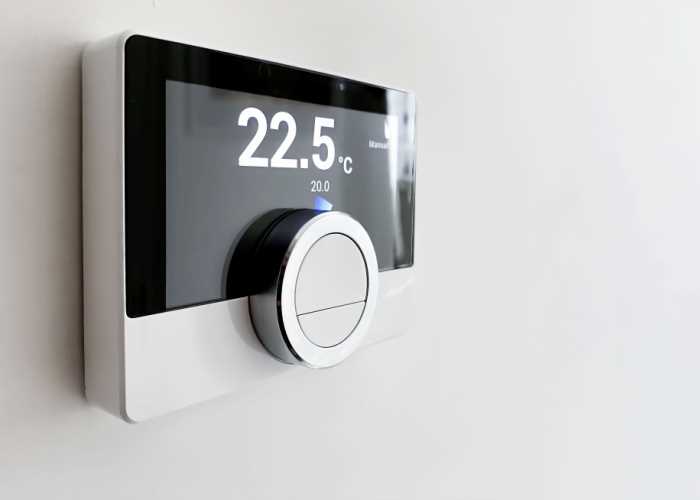Air source heat pumps are an increasingly popular form of technology thanks to their low energy consumption and dual purpose functionality - efficiently providing both heating and cooling for our homes.
But when it comes to maintaining a comfortable temperature, it’s the thermostat that ensures your indoor environment stays just the way you like it.
There are plenty of thermostats available, from the simplistic to sophisticated smart devices with advanced functionality. Here’s what you need to know to pick the ideal pairing for your heat pump system.
The short answer is yes, you do need a special thermostat for a heat pump. This is because heat pumps operate differently to traditional heating and cooling systems, so you need a thermostat specifically designed to optimise their performance.
Key functionalities to look for in a heat pump thermostat include:

Reversing valve control:
Heat pumps have a reversing valve that changes the flow of refrigerant, allowing them to provide both heating and cooling. A specialised thermostat for heat pumps is designed to control this reversing valve effectively, ensuring that the system switches between heating and cooling modes as needed.
Two stage operation:
Some heat pumps operate in two stages, meaning they have two levels of heating or cooling capacity. If you have a model that does incorporate two-stage operation, you'll need a thermostat that supports this feature. This ensures optimal control over the heat pump's stages, allowing it to efficiently adapt to varying temperature demands
Emergency heat function:
Heat pumps use auxiliary or emergency heat during extremely cold weather or when the system is defrosting. A dedicated heat pump thermostat is equipped to handle this emergency heat function, preventing issues with the system's performance during cold snaps.
Temperature swing settings:
Temperature swings, or the allowable range before the thermostat activates the heating or cooling system, should be adjustable. This feature helps prevent frequent cycling, improving energy efficiency and reducing wear and tear on the heat pump.
Energy efficient features:
Specialised heat pump thermostats often come with energy-saving features tailored to the unique characteristics of heat pumps. This may include smart technology, programmable settings, and compatibility with variable-speed systems, all contributing to increased energy efficiency.
Smart thermostats are your best option for maximising the efficiency and convenience of your heat pump system.
Unlike traditional mechanical or programmable thermostats, smart thermostats offer a range of advanced features that can enhance your heat pump’s operation, including:
Remote accessibility:
Smart thermostats allow you to control your heat pump remotely using a mobile app. This means you can adjust the temperature settings even when you're away from home, ensuring optimal comfort and energy efficiency.
Learning capabilities:
Many smart thermostats are equipped with learning algorithms that analyse your heating and cooling preferences over time. As a result, they can automatically create a schedule that aligns with your lifestyle and optimises energy usage.
Integration with smart home systems:
Smart thermostats often integrate seamlessly with popular smart home platforms, such as Amazon Alexa, Google Assistant, or Apple HomeKit. This integration allows you to control your heat pump using voice commands and may enable automation scenarios where your thermostat communicates with other smart devices in your home.
Energy usage reports:
Smart thermostats typically provide detailed energy usage reports. These insights help you understand your consumption patterns, identify opportunities for further energy savings, and make informed decisions to reduce your environmental footprint.
Geofencing technology:
Some smart thermostats use geofencing technology to detect when you're approaching home. By adjusting the temperature based on your proximity, these thermostats ensure that your living space is at the desired temperature when you arrive, without wasting energy when the house is empty.
Some popular manufacturers known for producing high-quality smart thermostats suitable for heat pump systems include:
Nest: Nest thermostats are renowned for their sleek design and advanced learning capabilities.
Ecobee: Ecobee thermostats are known for their compatibility with various HVAC systems and comprehensive smart home integration.
Honeywell: Honeywell offers a range of smart thermostats with features like geofencing and adaptive learning.
Google: with the Google Nest line of thermostats, you get the benefit of Google's expertise in smart technology and connectivity.
The integration of smart technology can significantly enhance the performance and efficiency of your heat pump system, providing a comfortable and energy-conscious living environment.
Just remember to consult your heat pump's specifications and consider your specific preferences when choosing the right smart thermostat for your home.

Having chosen the ideal thermostat for your heat pump, you need to carefully consider its placement to ensure accurate temperature readings. These are essential if you want your system to operate with maximum efficiency:
Interior wall location:
Install the thermostat on an interior wall to prevent exposure to extreme temperatures or direct sunlight. Exterior walls and areas directly affected by outdoor conditions can lead to inaccurate readings and inefficient temperature control.
Central location:
Choose a central location within the home to ensure that the thermostat represents the average temperature of the entire living space. Avoid placing it near draughty areas, windows, doors, or heat sources, as these can skew temperature readings.
Avoidance of obstructions:
Install the thermostat away from obstructions such as furniture, curtains, or other items that may block airflow around the device. Proper airflow ensures that the thermostat accurately senses the ambient temperature, allowing the heat pump to operate efficiently.
Height consideration:
Mount the thermostat at an appropriate height, typically at eye level, for easy access and visibility. This location facilitates convenient programming and adjustment of temperature settings.
Consideration of zoning:
If your home has multiple zones with separate thermostats controlling different areas, ensure that each thermostat is strategically placed within its respective zone for precise temperature control.
By paying attention to these placement considerations, you can optimise the performance of your heat pump system and enhance the overall comfort of your home.
If you have any doubts about the best location for your thermostat, consult with a professional HVAC technician who can provide guidance based on the specific characteristics of your living space and heat pump system.
